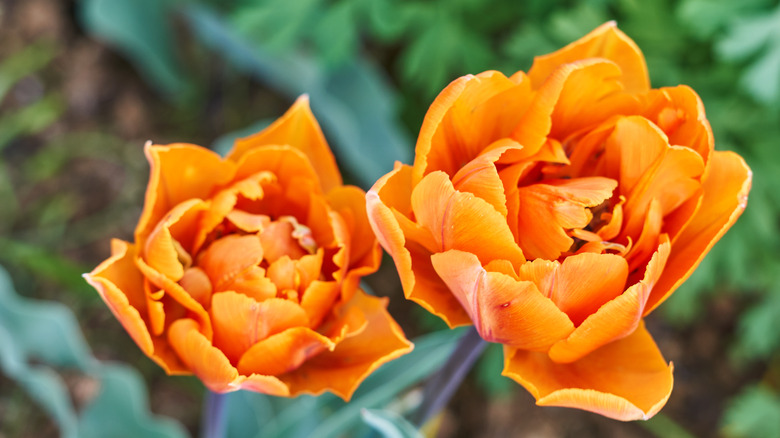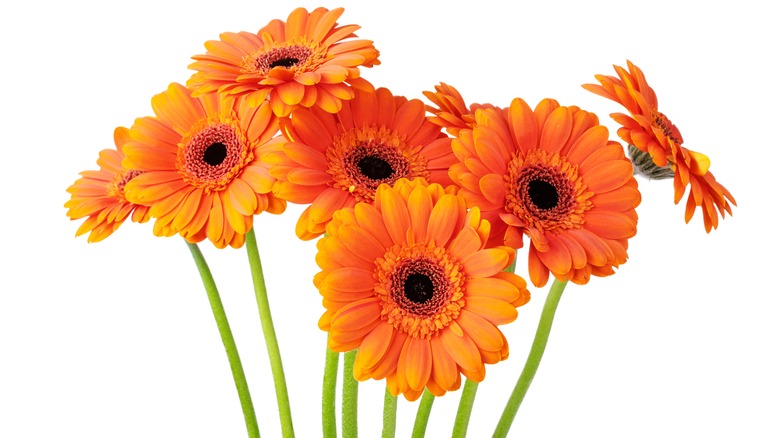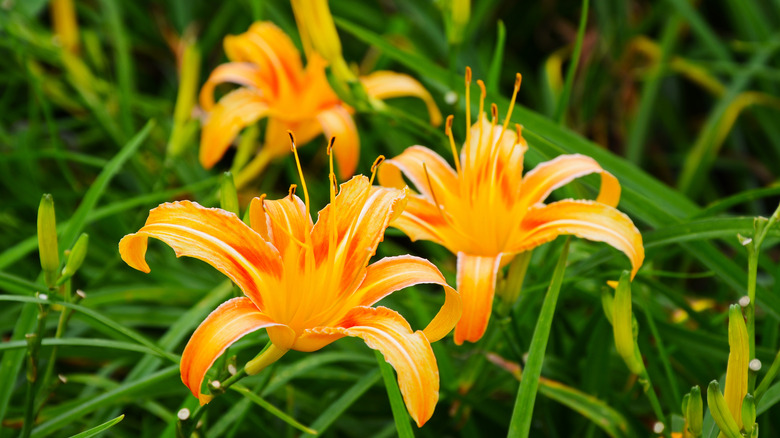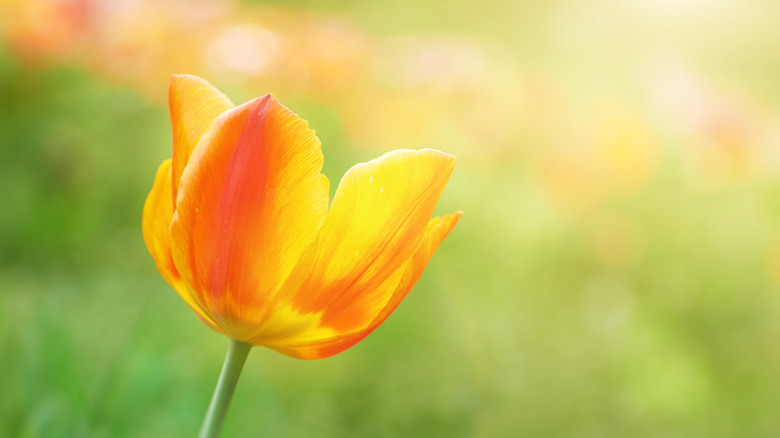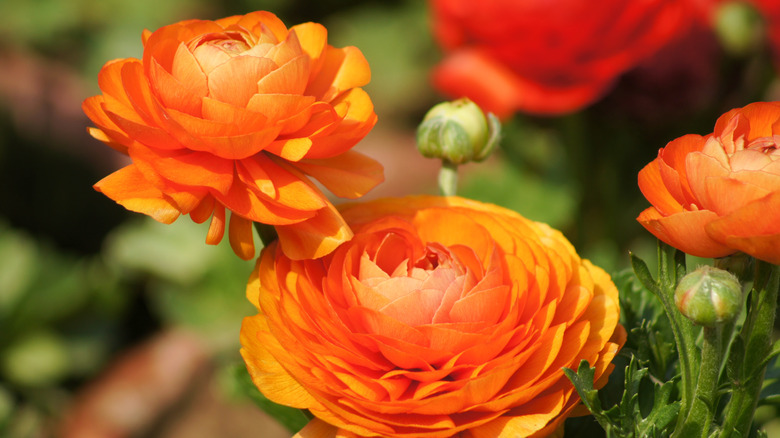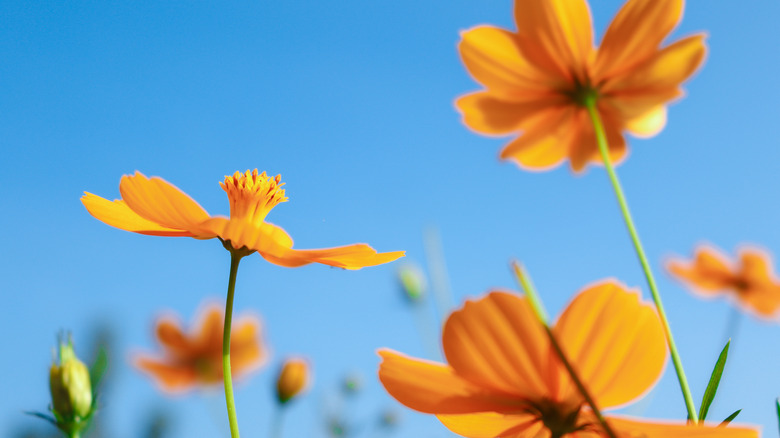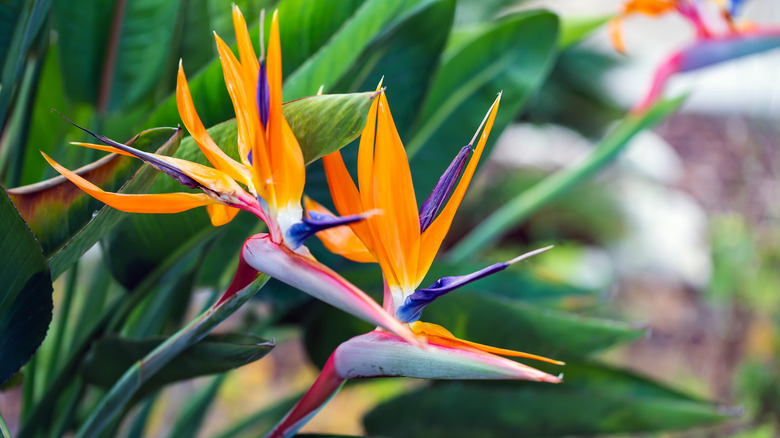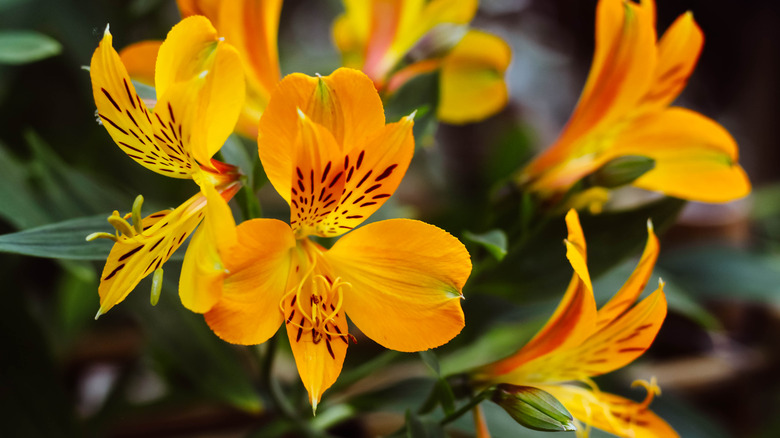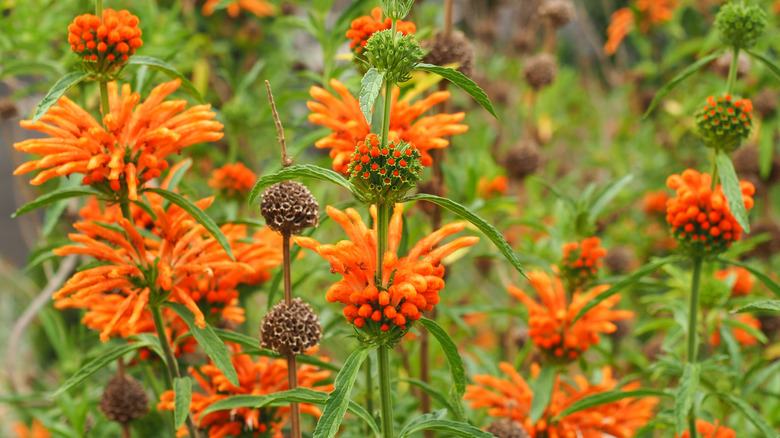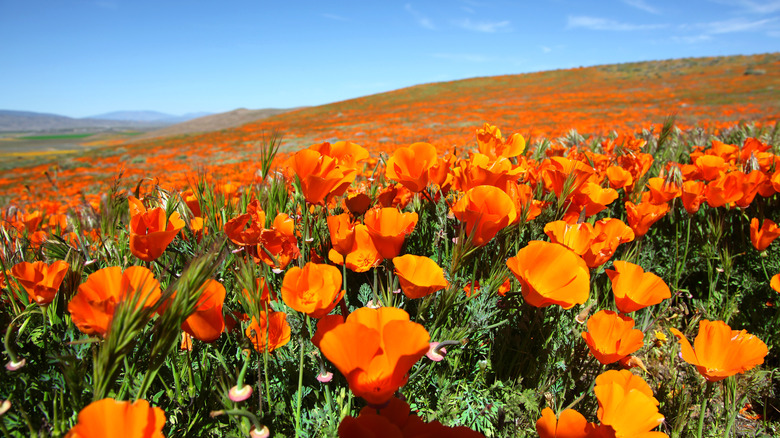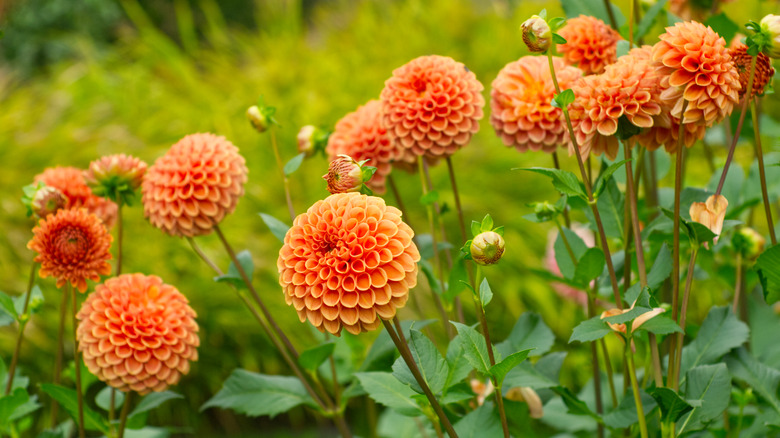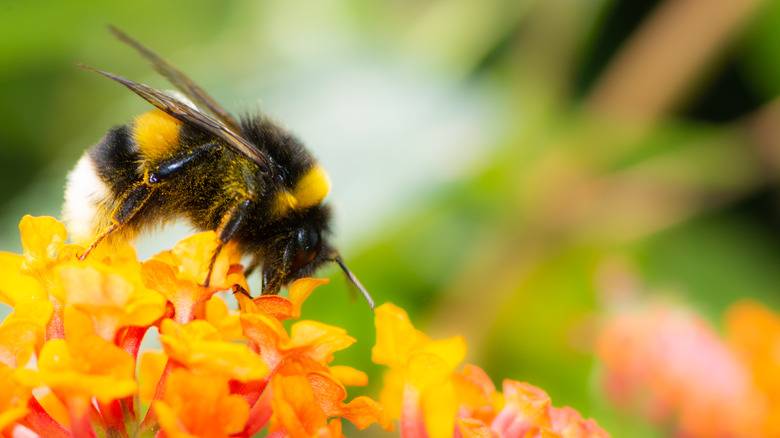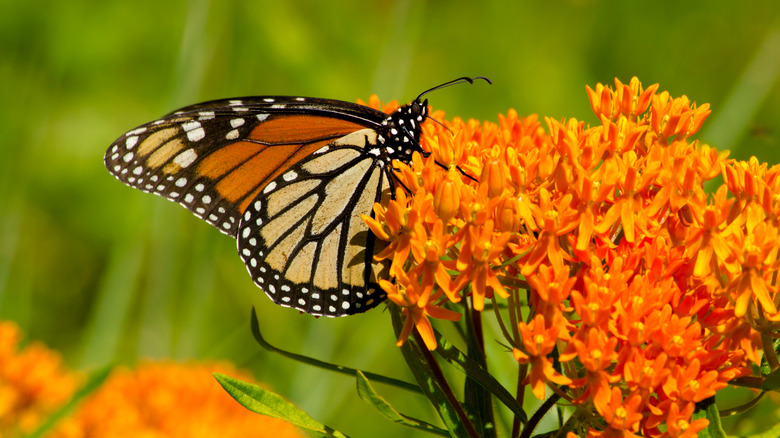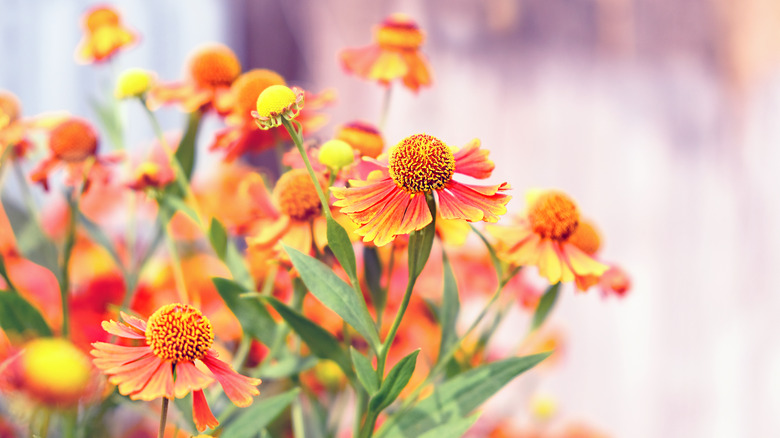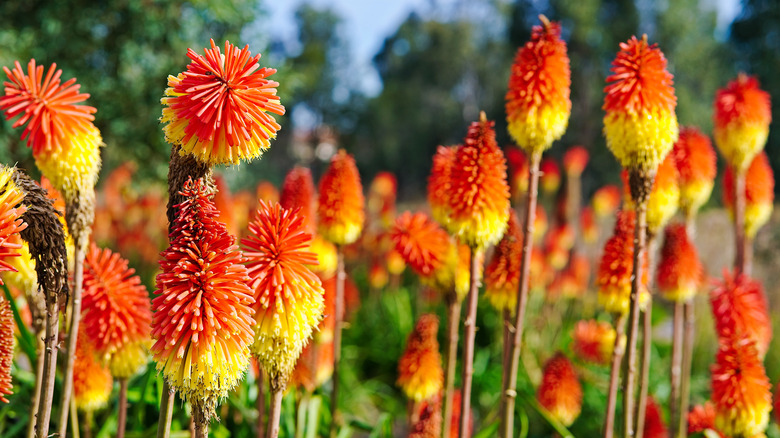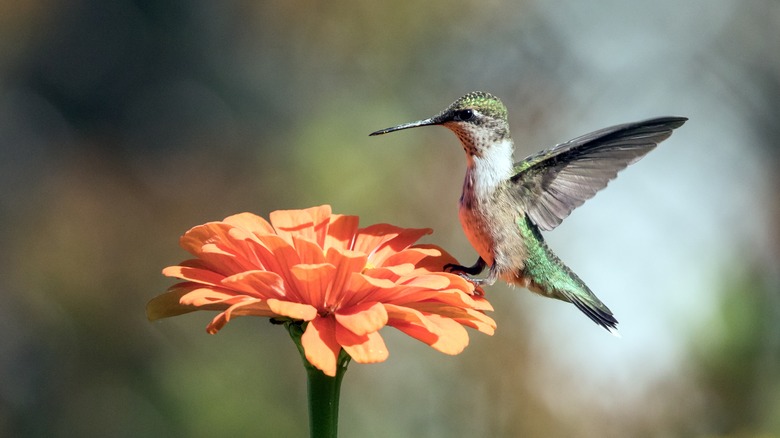15 Stunning Orange Flowers You Should Grow In Your Garden
Orange is a beautiful, attention-grabbing color to introduce into your garden. As described by Empowered by Color, it evokes a ray of sunshine and a warm glow of happiness. It also adds a rush of energy that will get you excited to spend more time outdoors, enjoying every breath of fresh air as your hands dig through the soil. There are many options for these gorgeous orange bloomers, and we've put together a list of the best flowers for various climate zones and soil conditions.
Plant tulip bulbs that will pop up in the spring and follow them up with summer blossoms like alstroemeria and California poppies. Your garden can stay abloom with an autumnal wash of deep auburn dahlias when fall rolls around. We've even got ideas for winter blooming flowers that can be brought inside during the colder months, if necessary. Whatever shade of orange you fancy, you'll find it here. So read on for various snazzy, eye-catching suggestions to add to your garden today.
1. Gerbera daisies
Bright and vivid, Gerbera daisies (Gerbera jamesonii) are so colorful they practically jump up and scream good morning. According to the Clemson Cooperative Extension Home & Garden Information Center, these South African natives are named after Traugott Gerbera, a German naturalist from the early 1700s. They are always an attention grabber and never disappoint in the garden or as cut flowers displayed in your home.
Bloom Season: Spring, summer, and early fall
USDA Growing Zone: 8 to 10
Growing Conditions: Morning sun, afternoon shade
Soil Type: Moist, well-draining; enriched with compost
Size: 6 to 18 inches tall, 9 to 12 inches wide
2. Daylilies
Daylilies (Hemerocallis spp.) are drought tolerant and incredibly easy to grow. Their flowers bloom large and are known for their ability to come back each new season with hardly any attention needed from the gardener. Per The Old Farmer's Almanac, the name daylily is a misnomer as they are not a lily plant variety, growing from tuberous roots instead of bulbs, but their beauty is equally stunning. A mature daylily will have six stems, or scapes, shooting up with 15 buds on each one.
Bloom Season: Spring, summer, and early fall
USDA Growing Zone: 4 to 9
Growing Conditions: Full sun; can tolerate some shade
Soil Type: Slightly acidic to neutral; can accept most soil types
Size: 1 to 2 feet tall, 1 to 2 feet wide
3. Tulips
Ahh, the tulip (Tulipa spp.), the epitome of spring awakening! The Longfield Gardens notes that tulip bulbs should be planted in the fall once the ground is cold and then basically forgotten about. These hardy growers need almost no care. They like a cold winter and pop up above ground as one of the first delightful signs of spring. Leaves may lift your doldrum winter spirits by beginning to show as early as February. These beauties look particularly lovely planted in large groupings in window boxes or along walkways.
Bloom Season: Spring
USDA Growing Zone: 3 to 7; possible in zone 8 if given plenty of shade
Growing Conditions: Sun or part shade
Soil Type: Well-draining, never soggy
Size: 6 to 12 inches tall, up to 6 inches wide
4. Ranunculus
Another spring beauty to consider is the ranunculus (Ranunculus asiaticus). Per the Garden Design, these flowers get their Latin name from rana, the word for frog, likely because they fare well in wetter climates. They are stunning and bright, commonly called Persian buttercups, and are tremendously popular among florists who employ them as cut flowers for bouquets. Ranunculus resemble roses with their light fragrant scent and petals that ruffle gently out from the center. They are winter hardy in temperature zones 8 to 11 but can be grown as annuals in colder zones 4 through 7.
Bloom Season: Late winter to early spring
USDA Growing Zone: 8 to 11
Growing Conditions: Morning sun, afternoon shade
Soil Type: Moist, well-draining
Size: 8 to 18 inches tall, 6 to 12 inches wide
5. Cosmos
Try adding Cosmos (Cosmos bipinnatus) to your garden for a breath of flirty energy. The Garden Gate explains that these flowers come in two common varieties: tall and sulphur. The sulphur cosmos will electrify your yard with a splash of tangerine orange, and, funny as it may sound, they often grow taller than the others. Deadheading spent blooms will keep your cosmos blooming all the way until the first frost.
Bloom Season: Summer and fall
USDA Growing Zone: 2 to 11
Growing Conditions: Full sun
Soil Type: Moist, well-draining
Size: 1 to 6 feet tall, 2 to 3-inch wide blooms
6. Bird of paradise
The official flower of Los Angeles, CA, the bird of paradise (Strelitzia reginae), is undoubtedly a unique, exotic option. The flowers of this plant stand out in any tropical or subtropical garden for their bright colors and the way they resemble birds with pointy beaks and fanciful head plumes. The San Diego Zoo Wildlife Alliance Plants & Animals mentions that they can also be grown indoors in colder climates.
Bloom Season: Late winter to early spring
USDA Growing Zone: 10 to 12
Growing Conditions: Full sun to partial shade
Soil Type: Fertile, rich, well-draining
Size: 4 to 6 feet tall, 3 to 4 feet wide
7. Alstroemeria
According to the North Carolina Extension Gardener Plant Toolbox, whether you call them lily of the Incas or a parrot, Peruvian, or princess lily, you have seen alstroemeria in store-bought floral bouquets. This perennial plant lives carefree in temperate climate zones, but it also does just fine potted and brought inside when it gets cold. Per Better Homes and Gardens, alstroemeria requires little maintenance and are somewhat drought resistant due to their tubers which retain moisture from under the ground. But these flowers are an excellent choice for filling space and adding contrast to an otherwise monotoned landscape.
Bloom Season: Summer
USDA Growing Zone: 6 to 10
Growing Conditions: Full sun to part sun
Soil Type: Moist, well-draining
Size: 1 to 3 feet tall, 1 to 2 feet tall
8. Lion's tail
Sometimes called the lion's ear or wild dagga, the lion's tail flowers (Leonotis leonurus) blossom from large plants that can grow up to 6 feet tall in a single year. The folks at Annie's Annuals & Perennials absolutely adore these South African natives for many reasons, including their ease of growth, tolerance to both drought and excessive heat, and natural resistance to those hungry deer roaming through the backyard. A lovely bonus feature of having lion's tails in your garden is the hummingbirds, bees, and butterflies they are sure to attract.
Bloom Season: Late spring, summer, and fall
USDA Growing Zone: 8 to 11
Growing Conditions: Full sun
Soil Type: Low moisture, well-draining
Size: 4 to 6 feet tall, 4 to 6 feet wide
9. California poppy
Per the U.S. Forest Service, the state flower of California (Eschscholzia californica) was named after a surgeon on board an exploring Russian ship that arrived on the west coast in the early 1800s. These cheerful bloomers can reseed themselves, live for many years, and grow in a wide range of environmental conditions across the U.S. While its botanical extract may have sedative properties, there is no need to worry about growing poppies in your garden. If you're still concerned, try planting many of them together in large containers or barrels that are elevated above the ground.
Bloom Season: Spring and summer
USDA Growing Zone: 8 to 10
Growing Conditions: Full sun
Soil Type: Sandy, well-draining
Size: 6 inches to 1 feet tall, 6 inches to 8 inches wide
10. Dahlia
The captivating spherical blossoms of the dahlia may not bloom until the end of August, but they are definitely well worth the wait. Trumpeting the imminent arrival of autumn, dahlias give us one last pop of botanical delight before summer officially comes to an end. For an array of orange varieties in your garden, Gardener's World recommends the cantaloupe-hued Dahlia Gwyneth, the lighter, peachier miniature Dahlia David Howard, or the darker, red-orange Dahlia Sylvia.
Bloom Season: Summer and fall
USDA Growing Zone: 8 to 10
Growing Conditions: Full sun
Soil Type: Light, sandy, well-draining with added fertilizer
Size: Varies, up to 5 feet tall, 2 feet wide
11. Lantana
According to the University of Florida's IFAS Gardening Solutions, lantanas (Lantana camara) are just about the most popular flowers for landscape design, and for a good reason. Bees love them for their bright bursts of color, and gardeners adore them for their ease of growth. Landscapers value lantanas because they can be planted in hot, dry, and even salty environments. But there are also downsides to these stunning pollinator magnets; lantanas are classified as invasive plants and can be toxic when ingested by livestock.
Bloom Season: Year-round in warm climates; spring through fall otherwise
USDA Growing Zone: 7 to 12
Growing Conditions: Full sun, flowers more with regular watering
Soil Type: Well-draining sandy loam
Size: 1 to 6 feet tall, up to 4 feet wide
12. Butterfly weed
How about the carrot orange-hued, low-lying butterfly weed (Asclepias tuberosa) for something different? This flower is a favorite of the monarch butterfly, and it blooms in clusters of tiny flowers that can span up to 5 inches. Although it is a member of the Asclepiadaceae milkweed family, it does not contain any sticky or milky sap, so no worries about adding a mess to your landscape design or gardening gloves. Botanists from the Lady Bird Johnson Wildflower Center note that indigenous peoples used the root of the butterfly weed to remedy pulmonary issues.
Bloom Season: Spring and summer
USDA Growing Zone: 8 to 10
Growing Conditions: Full sun
Soil Type: Sandy, well-draining
Size: 24 to 36 inches tall, 12 to 24 inches wide
13. Helenium
Who would have thought that Helenium (Helenium autumnale), a flower nicknamed sneezeweed, is not known to cause allergies? According to the Wisconsin Horticulture Division of Extension, the modern hybrids of this flower produce much more robust plants than their ancestors. New varieties will bloom for months, with the orange sneezeweed starting to show off its adorable flowers by the middle of summer. Terminal clusters are packed densely, making this a great plant to weave through a cottage garden. Mix it with other late-season bloomers like the daylilies and dahlias for an incredible gardening experience.
Bloom Season: Summer and fall
USDA Growing Zone: 3 to 8
Growing Conditions: Full sun
Soil Type: Rich, moist, well-draining
Size: 2 to 5 feet tall, 1 to 2-inch wide blooms
14. Red hot poker
With tall, torch-like stalks that end in a wave of yellow, orange, and red, all in one long and narrow blossom, it's no wonder this flower is called the red hot poker (Kniphofia uvaria). Red hot pokers attract hummingbirds with tubular, nectar-filled flowers, and a single bloom can last for almost three weeks! These flowers have heavy water requirements, so they're a great addition to a yard with a pond, but they'll also look spectacular in containers where they can become an eye-catching focal point. For bouquets, American Meadows recommends pairing them with natural grasses.
Bloom Season: Summer and fall
USDA Growing Zone: 6 to 9
Growing Conditions: Full sun
Soil Type: Moist yet well-draining
Size: 3 to 8 feet tall, 1 to 2 feet wide
15. Zinnia
Tried and true, everyone knows that zinnias (Zinnia elegans) make wonderfully colorful additions to your floral design while attracting butterflies and hummingbirds to the yard. But they're also great for the vegetable garden. According to the Old Farmer's Almanac, zinnias make great companion plants for zucchini, chard, and dwarf beans. Did you know that zinnia petals are edible? Having them at hand to spruce up a boring salad is another excellent reason to include them in your garden!
Bloom Season: Late spring, summer, and fall
USDA Growing Zone: 9 to 11 as perennials; grown as annuals otherwise
Growing Conditions: Full sun
Soil Type: Well-draining; enriched with organic matter
Size: 1 to 4 feet tall, 12 to 18 inches wide
